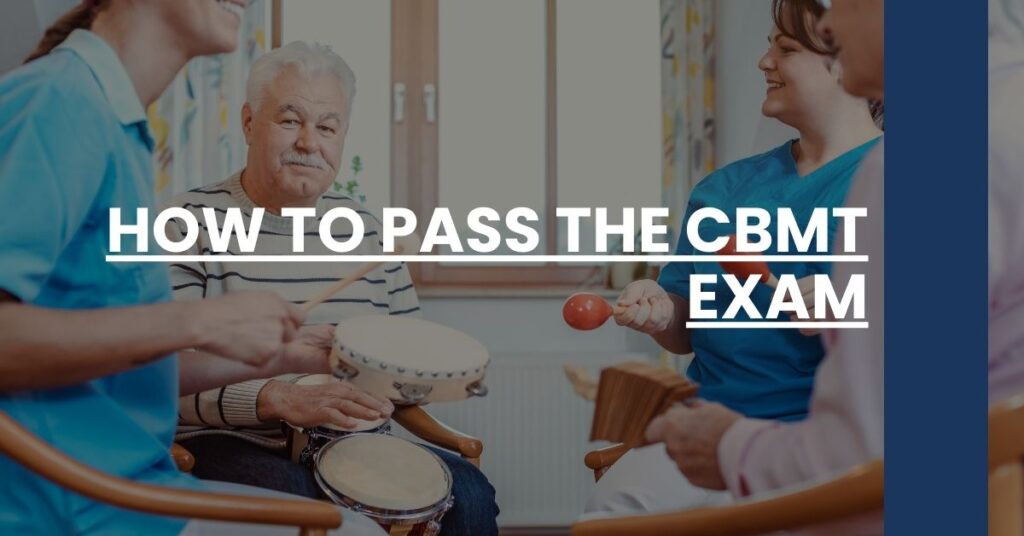How to pass the CBMT exam is more than a goal; it’s a journey towards becoming a licensed music therapist.
- Study Resources for the CBMT Exam: Access official materials and community forums for up-to-date content.
- Effective Study Techniques: Implement active learning methods to enhance recall and understanding.
- Practice Exams: Utilize mock tests to gauge your preparation level and adjust your study plan accordingly.
Unlock the secrets of how to pass the CBMT exam with strategic preparation.
Understanding the CBMT Exam
The Certification Board for Music Therapists (CBMT) Exam is a pivotal step for music therapy practitioners seeking to obtain their Music Therapist-Board Certified (MT-BC) credential. This certification is not just a testament to your dedication and expertise in the realm of music therapy; it’s a recognized standard ensuring that those holding the MT-BC title meet the high level of proficiency required to practice safely and effectively.
What is the CBMT Exam?
At its core, the CBMT Exam is designed to evaluate your knowledge and skills across the vast spectrum of music therapy. Passing it confirms that you are well-prepared to address clients’ therapeutic needs using an evidence-based music therapy practice framework. The exam covers a range of topics including assessment, treatment planning, implementation, documentation, evaluation, and professional development in music therapy.
Why is it Important?
Achieving a passing score on the CBMT Exam not only grants you the MT-BC credential but also conveys to employers, clients, and the healthcare community at large that you are committed to maintaining the highest standards of music therapy practice.
Creating a Study Plan
When pondering how to pass the CBMT exam, a well-structured study plan is your roadmap to success. It breaks down an overwhelming challenge into manageable tasks, making the mountain of material feel more like a series of small hills.
Setting Your Study Timeline
Start by marking your exam date on the calendar, then work backward to allocate study time effectively. Dedicate blocks of time each day or week specifically for studying, ensuring that every domain of the exam is covered.
Assessing Study Materials
Collecting the necessary study materials, such as the CBMT Exam Candidate Handbook, serves as the foundation for your study plan. Ensure that these resources are both comprehensive and current to avoid any surprises on exam day.
Accountability Measures
Staying on track often requires accountability. You might pair up with a study buddy, enlist the help of a mentor, or join a CBMT study group. Regular check-ins can keep you focused and give you a chance to calibrate your progress.
Incorporating Different Learning Styles
Understand your learning style—be it auditory, visual, kinesthetic, or a combination—and tailor your study methods accordingly. By aligning your study plan with how you learn best, you’ll retain information more effectively and make the most of your study sessions.
Strategies for Effective Studying
Effective studying for the CBMT exam requires more than just reading textbooks and memorizing facts. Apply strategies that fit your lifestyle and learning preferences to enhance retention and comprehension.
Active Learning Techniques
Active learning techniques, like teaching back the material to an imaginary classroom, can deepen your knowledge. Create diagrams or mind maps to visualize relationships between concepts, making the details more memorable.
Self-assessment Tools
Regularly using self-assessment tools, including flashcards or practice tests, helps you gauge your understanding and pinpoint areas needing further study. Apps and online quizzes can be particularly useful for quick, on-the-go testing.
The Role of Rest
Don’t underestimate the power of rest and sleep in consolidating your knowledge. Regular breaks during study sessions can prevent burnout and promote long-term recall.
Recall Strategies
Implementing recall strategies is also critical. After reviewing a topic, close your books and try to write down everything you remember. This exercise will quickly show you what has stuck and what hasn’t, giving you direct insight into which areas to revisit.
With consistent effort, a clear strategy, and a mindful approach to your learning habits, mastering how to pass the CBMT exam becomes an achievable goal, perfectly aligned with your professional journey in music therapy.
Practice and Mock Exams
One of the most effective ways to prepare yourself for the CBMT exam, to understand how to pass the CBMT exam successfully, is through rigorous practice with mock exams. These practice sessions are invaluable as they help simulate the actual exam environment, which can alleviate anxiety and improve your test-taking stamina.
The Value of Repetition
Consistent practice with mock exams and various practice questions will make you familiar with the format of the CBMT exam. It’s well-documented that repetition can enhance your self-confidence and reduce the risk of encountering unpleasant surprises on exam day.
- Identify Weak Areas: Through practice exams, you will discover which areas you have mastered and which require more attention.
- Time Management: Calibrating how long you spend on each question during these practice sessions can help you pace yourself better during the actual exam.
Practicing under timed conditions can turn a formidable task into a routine exercise, thereby making the concept of how to pass the CBMT exam feel much more within your grasp.
Feedback Loop
After each mock exam, thoroughly review your answers, especially the incorrect ones. Use this feedback to refine your study plan and devote more time to your weaker areas.
Test-Taking Strategies
Developing solid test-taking strategies is crucial when considering how to pass the CBMT exam. While mastering the content is essential, so is knowing how to approach the test.
Multiple-Choice Mastery
The CBMT exam primarily consists of multiple-choice questions, and learning how to navigate them can significantly affect your performance:
- Read All Options: Carefully read all answer choices before selecting one.
- Eliminate Wrong Answers: Rule out obviously incorrect options to improve your chances of choosing the right one.
- Pace Yourself: Keep an eye on the time and ensure you’re moving at a pace that will allow you to complete the exam.
Coping with Pressure
To stay calm during the exam, practice deep breathing techniques and remind yourself that you have prepared well. If you find yourself stuck on a question, it’s often helpful to move on and return to it with fresh eyes later.
During the Exam
- Trust Your First Instinct: Often, your first choice is the correct one unless you recall new information that changes your perspective.
- Stay Positive: Maintain a confident mindset throughout the exam, as stress can cloud judgment and recall.
Embracing these strategies while continuously asking yourself how to pass the CBMT exam will contribute significantly to your potential for success.
Day Before and Day of the Exam Tips
Ensuring you’re in peak mental and physical condition the day before and the day of the CBMT exam is just as important as knowing the content. A well-rested mind will greatly contribute to your faculty’s peak performance.
The Night Before
On the eve of the exam, put aside your study materials and trust in the hard work you’ve already put in. Prepare your items for the next day, get a good night’s rest, and try to relax.
Exam Day
On the day of the test, eat a nutritious breakfast to fuel your brain, arrive at the testing center early to reduce stress, and dress comfortably for maximum focus.
Dealing with Test Anxiety
Test anxiety is a common hurdle for many, and overcoming it is a significant aspect of knowing how to pass the CBMT exam. Managing your nerves requires a strategic approach that can include:
- Mindfulness and Breathing Techniques: Simple exercises can center your focus and calm your nerves.
- Visualization: Envisioning yourself succeeding can bolster a positive mindset and reduce anxiety.
Implementing such techniques can reshape your exam experience, transforming it from a source of dread into an opportunity to showcase your hard-earned knowledge.
After the Exam: Next Steps
Once the CBMT exam is behind you, what comes next hinges on your results:
- Passing: Receiving a passing score is cause for celebration and marks the beginning of the next phase of your career as a certified music therapist.
- Falling Short: If you do not pass, take the time to review your exam report, identify knowledge gaps, and plan your next steps.
Whether the outcome is positive or otherwise, the experience itself is a valuable learning opportunity that can help shape your future study strategy or professional practice.
Conclusion
Approaching how to pass the CBMT exam can seem daunting at first glance. Yet, by breaking down the process into a series of strategic steps—covering everything from creating a study plan to honing your test-taking skills—you stand to elevate your preparation and poise yourself for success.
Equipped with solid study habits, a deeper understanding of the exam format, and a toolkit of strategies for managing nerves and maximizing your exam performance, you’re ready to face the CBMT exam head-on. Believe in your abilities, trust in the preparation process, and step forward confidently into your role as a music therapy professional.
How to pass the CBMT exam effectively: Essential strategies, study guides, and test-taking tips for music therapists’ success.

